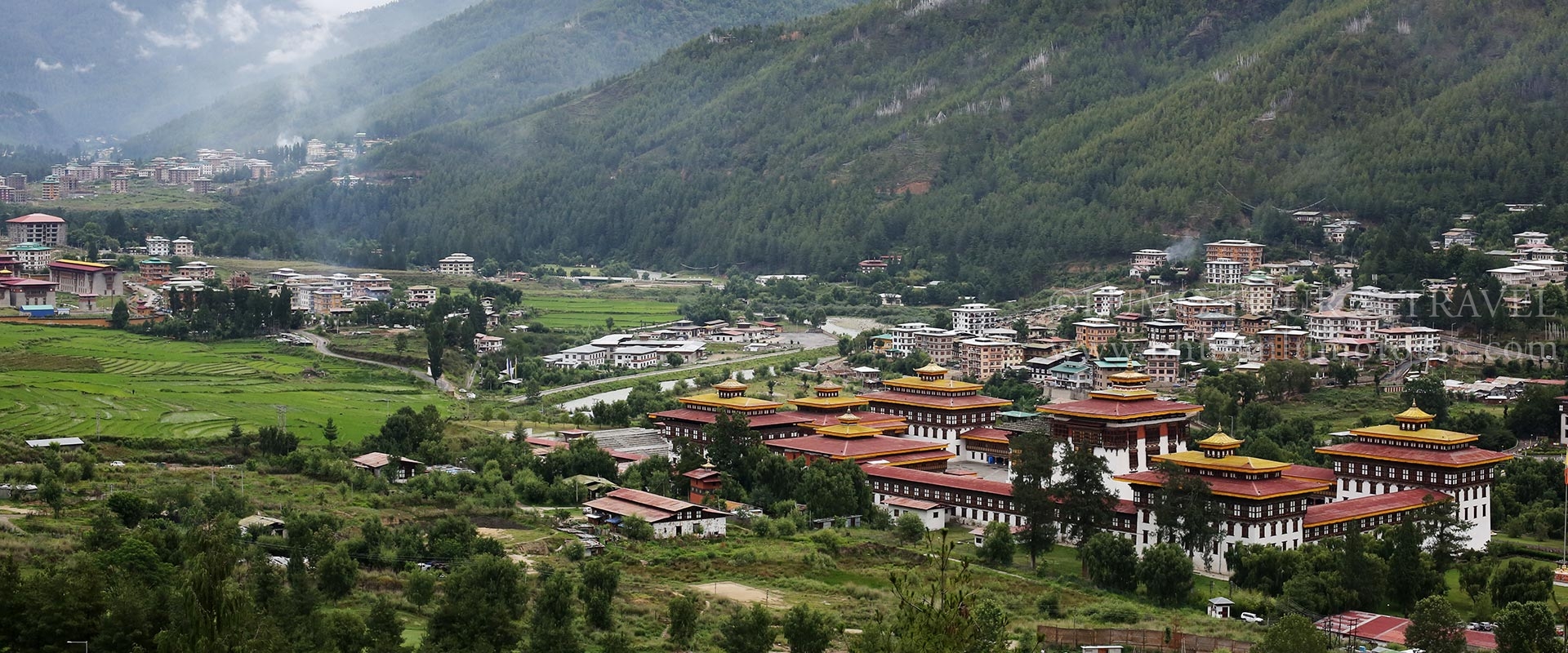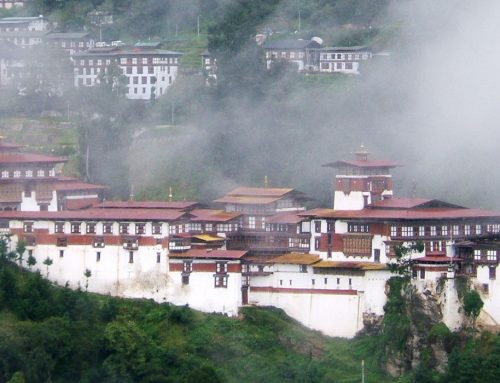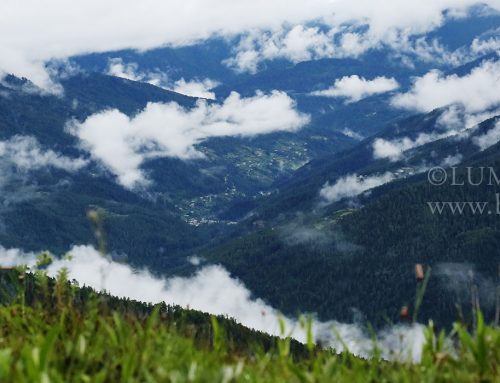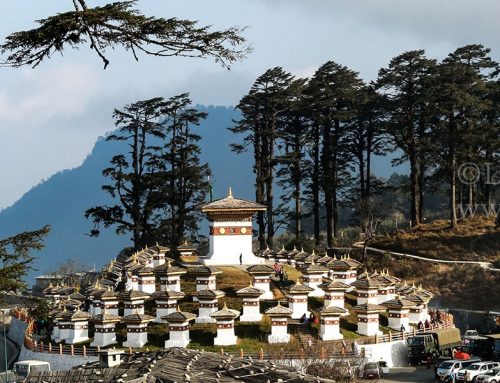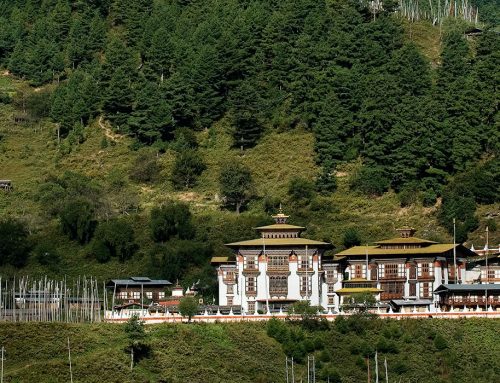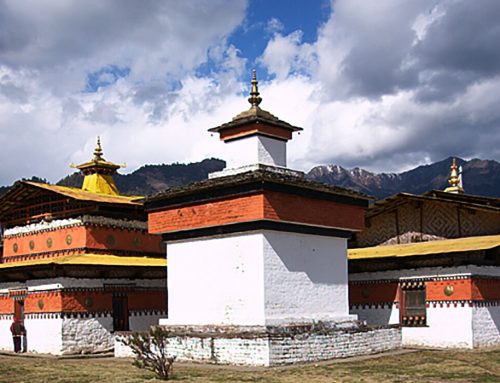- Duration: 4 nights / 5 days
- Accommodation: Hotels, Resorts and Guest Houses.
- Distance & Driving time:
- Paro to Thimphu – 54 Km – 1 Hr.
- Thimphu to Punakha – 76 Km – 3 Hrs
- Punakha to Wangdue – 17 Km – 40 Mins
- Highest altitude: Dochu La Pass (3140m).
- Visit to the largest Statue of Buddha in Bhutan
- Memorial Chorten
- Punakha Dzong (built in 1637)
- A Panoramic view of the Himalayas from the Dochula Pass (3140m)
- Chimi Lhakhang – “The Temple of Fertility”
- A farm house visit
- Excursion to famous Taktsang – “The Tiger’s Nest”
- Visit to Drugyal Dzong – “The Fortress of victory” (built in1644)
- Kichu Monastery
Day 01. Arrive at Paro (2280 meters)
Your guide from Druk & Drukpa Travels will receive you at the Paro Airport and escort you to Thimphu, the capital city of Bhutan.
In the evening, visit Tashichho Dzong (Fortress of the Glorious Religion). The dzong was built in 1641 by Zhabdrung Ngawang Namgyel. It was renovated in 1961 by the late king, His Majesty King Jigme Dorji Wangchuck. Then visit the Handicrafts Emporium to see the exquisite artistry of traditional crafts and textiles.
Over night in Hotel.
Day 02. Thimphu – Punakha – Wangduephodrang (1310 m) (83 Km 3 hours drive)
After breakfast, drive to Punakha via Dochula Pass. If the weather is clear, we stop for a while at Dochula to get a glimpse of the towering Himalayas.
In Punakha, visit Punakha Dzong built in 1637 by Zhabdrung Ngawang Namgyel. It is situated at the confluence of Pho Chu (Male River) and Mo Chu (Female River). The place was once the capital city of Bhutan.
The construction of the Dzong is believed to have been foretold by Guru Rinpoche. The small dzong called Dzongchung that exists even today housed a statue of Buddha. It is said that Zhabdrung ordered the the architect, Zowe Palep, to sleep in front of the statue. While Palep was sleeping, the Zhabdrung took him in his dreams to Zangtopelri (Paradise) and showed him the palace of Guru Rimpoche. From his vision, the architect conceived the design for the new Dzong. The design was never put on paper. The Dzong was named Druk Pungthang Dechen Phodrang (Palace of Great Happiness). The war materials captured during the battle with Tibetans are preserved here. Punakha is still the winter residence of Je Khenpo ( the chief abbot of Bhutan).
The third king, Jigme Dorji Wangchuck, convened the first National Assembly in Punakha in 1952.
After Lunch, drive to Wangduephodrang. En route stop a while to view Chimi Lhakhang also called the “Temple of Fertility” built by Lama Drukpa Kuenley, who is popularly known as “The Devine Mad Man”, in the 15th century. And sightseeing in the valley of Wangduephodrang include: visit to Wangduephodrang Dzong, built in 1638. Legend has it that as the people were searching for the site of the dzong, four ravens were seen flying away in four directions. This was considered auspicious sign representing the spread of the religion in the four points of the compass. The dzong is situated at the confluence of Mo Chu (Male River) and Dang Chu rivers. Overnight in Hotel.
Day 03. Wangduephodrang – Thimphu (2320 meters) 76 km
After breakfast, drive to Thimphu. After lunch, visit the National Memorial Choeten, a monument dedicated to the third King Late Majesty Jigme Dorji Wangchuck. The inside paintings and statues provide a very rare insight into the Buddhist Philosophy. Then visit the National Library, which holds a vast collection of ancient Buddhist scriptures and modern literature on diverse subjects. Then visit the Institute of Zorigchusum, the institute where traditional arts and crafts are taught. And then the Folk Heritage Museum.
In the evening, go to Sangaygang from where you can see a bird’s eye view of the capital city. Visit the Takin’s (the national animal) zoo and one of the largest Buddhist statutes. Overnight in Hotel.
Day 04. Thimphu – Paro Sightseeing: (Altitude 2320 m)
After breakfast, drive to Paro. A special day with an excursion to the spectacular Taktsang (Tiger’s Nest) monastery.
A short drive takes us to Satsam Choeten, from there a 2-hour walk to the viewpoint of the monastery. The trail climbs through beautiful pine forest with trees festooned with Spanish moss and an occasional grove of fluttering prayer flags.
We stop to rest and for light refreshments at the Taktsang Jakhang (cafeteria) and then walk a short distance until we see the clear view of Taktsang monastery. The main Lhakhang at the monastery was built around Guru Rimpoche’s meditation cave in 1684 by Gyaltse Tenzin Rabgye.
This incredible monastery clings to the edge of a sheer rock cliff that plunges 900 meters into the valley below. Legend has it that Guru Padmasambhava, the tantric mystic who brought Buddhism to Bhutan, flew here on the back of a flying tigress, said to be his favorite consort.
After Lunch, visit Ta Dzong (built in1656 and renovated in 1968), an ancient watchtower, which now houses the National Museum. Below the museum is Paro Rimpung Dzong (meaning “Heap of Jewels,”) built in 1646 by Zhabdrung Ngawang Namgyel. A short walk takes you to the base of the dzong across a traditional cantilever bridge.
In the evening, visit Drukgyel Dzong in ruins. It was built by Zhabdrung Ngawang Namgyel to commemorate the victory over the Tibetan invaders in 1644. The dzong’s name indeed means “Victorious Druk.” The Dzong was used as an administrative center until 1951 in which year a fire caused by butter lamp destroyed it. Then visit Kyichu Lhakhang. It is one of Bhutan’s oldest and most sacred monasteries.
Dinner and overnight at the hotel in Paro.
Day 05. Departure: Early morning, drive to the airport and farewell.
- All Meals [Breakfast /Lunch/Dinner]
- Accommodation [Twin Sharing] Single Room Supplement Extra US $: 40 per room per night.
- All transportation within the country including airport transfers.
- Royalty & Govt. Taxes
- Entrance fees for Museums and Monuments only
- Visa Fee.
- Airport tax
- Tourism Development fund
- Sightseeing
- Druk Air fare.
- Insurance Premiums,
- Payments for service provided on a personal basis
- Cost for any services not mentioned in the “Cost Include head”.


